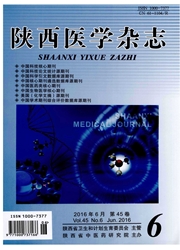

 中文摘要:
中文摘要:
目的:探讨骨化三醇冲击和每日治疗终末期肾脏病(ESRD)并发性甲状旁腺功能亢进(SHPT)患者的疗效。方法:将50例并发SHPT的ESRD患者随机分为两组,常规组每日给予骨化三醇胶丸(0.25μg/d),冲击组患者则给予冲击疗法,比较两组患者治疗前后血iPTH、钙磷及ALP水平的变化。结果:冲击组在治疗4周后、常规组治疗8周后血iPTH开始较治疗前明显下降,冲击组血iPTH在治疗4周、8周、12周均明显低于常规组(P〈0.05);两组患者治疗12周后血钙均明显上升(P〈0.05),血ALP均明显下降(P〈0.05);两组患者治疗后血磷与治疗前比较无显著性差异(P〉0.05)。结论:骨化三醇治疗ESRD并发SHPT患者安全有效,冲击疗法对降低血iPTH更具有优势。
 英文摘要:
英文摘要:
Objective: To investigate the clinical effect of routine and pulse dosage of calcitriol for the treatment of secondary hyperparathyroidism(SHPT) in patients with end-stage renal disease(ESRD). Methods: 50 cases of ESRD patients with SHPT were randomly divided into two groups, the conventional group were given calcitriol capsules (0.25/zg / day), the shock group were treated with pulse dosage therapy, before and after treatment, the level of blood iPTH, calcium ,phosphorus and ALP were compared. Results: The serum iPTH in shock group were at four, and in the conventional group were at eight weeks after treatment were decreased than before treatment, and that in the 4 weeks, 8 weeks, 12 weeks were significantly lower than conventional group, the differences were statistically significant (P〈 0. 05) the serum calcium in two groups were significantly increased after 12 weeks, serum ALP were significantly decreased, the difference were statistically significant (P〈0.05)~ there were of no statistical difference between the two groups of serum phosphorus (P〉 0.05). Conclusion: The treatment of calcitriol on patients with SHPT is safe and effective , but the pulse dosage therapy is of more advantages for reduc- ing thelevel of iPTH.
 同期刊论文项目
同期刊论文项目
 同项目期刊论文
同项目期刊论文
 期刊信息
期刊信息
